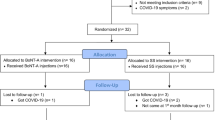Abstract
This research compares different treatment regimes for the management of chronic facial pain associated with the masticatory musculature. Twenty-one females meeting specific criteria were randomly assigned to one of three treatment conditions: a dental splint and physiotherapy program; a relaxation program utilizing progressive muscle relaxation, biofeedback, and stress management techniques; or a minimal treatment program involving transcutaneous electrical nerve stimulation. Improvement was assessed through a dental examination, self-monitoring of pain, and an assessment of EMG activity during resting and task conditions. Significant changes were obtained in response to all treatment programs. The treatment programs differed only in the relative pattern of treatment effects obtained from the self-report monitoring of pain. The data are consistent with the concept of MPD as a psychological response to stress which maintains chronic pain through increased muscle tension in the jaw.
Similar content being viewed by others
References
Bell, W. E. (1969). Clinical diagnosis of the pain-dysfunction syndrome.Journal of the American Dental Association, 79(1), 154–160.
Gelb, H. (1985). Effective management of the cranial-mandibular system. In H. Gelb (Ed.),Clinical management of head, neck and TMJ pain and dysfunction (2nd ed., pp. 307–324). Philadelphia, Pennsylvania: Saunders Press.
Greene, C. S. (1979). Myofascial pain dysfunction syndrome: The evolution of concepts. In B. Sarnat, & D. Laskin (eds.),The temporomandibular joint. (3rd ed., pp. 277–298). Springfield: Charles C. Thomas.
Greene, C. S., & Laskin, D. M. (1983). Long-term evaluation of treatment for myofascial pain dysfunction syndrome: a comparative analysis.Journal of the American Dental Association, 107(2), 325–238.
Griffith, R. H. (1983). Report of the President's conference on the examination, diagnosis, and management of temporomandibular disorders.Journal of the American Dental Association, 106(1), 75–77.
Guralnick, W., Kaban, L., & Merrill, R. G. (1978). Temporomandibular joint afflictions.New England Journal of Medicine, 299(3), 123–129.
Helkimo, M. (1976). Epidemiological surveys of dysfunction of the masticatory system.Oral Science Review, 7 54–69.
Hymes, A. C., Raab, D. E., & Yonehiro, E. G. (1975). Electrical surface stimulation for control of acute post-operative pain and prevention of ileus.Surgical Forum, 26 474–476.
Lampe, G. N. (1978). Introduction to the use of transcutaneous electrical nerve stimulation devices.Physical Therapy, 58(12), 1450–1454.
Laskin, D. M. (1969). Etiology of the pain-dysfunction syndrome.Journal of the American Dental Association, 79(1), 147–153.
Melzack, R. (1975). The McGill Pain Questionnaire: major properties and scoring methods.Pain 1(3). 277–299.
Moss, R. A., Garrett, J., & Chiodo, J. F. (1982). Temporomandibular joint dysfunction and myofascial pain dysfunction syndromes: Parameters, etiology, and treatment.Psychological Bulletin, 92(2), 331–346.
Moulton, R. E. (1955). Psychiatric considerations in maxillofacial pain.Journal of the American Dental Association, 51 408–416.
Okeson, J. P., Moody, P. M., Kemper, J. T., & Haley, J. V. (1983). Evaluation of occlusal splint therapy and relaxation procedures in patients with temporomandibular disorder.Journal of the American Dental Association, 107(3), 420–424.
Parloff, M. (1986). Placebo controls in psychotherapy research: a Sine Qua Non or a placebo for research problems?Journal of Consulting and Clinical Psychology, 54(1), 79–87.
Reitan, R., and Davison, L. A. (Eds.). (1974).Clinical Neuropsychology: Current Status and Applications. New York: John Wiley and Sons.
Rosenberg, M., Curtis, L., and Bourke, D. L. (1978). Transcutaneous electrical nerve stimulation for the relief of postoperative pain.Pain, 5 129–133.
Rugh, J. D. (1983). The future in dentistry: Temporomandibular disorders.Journal of the American Dental Association, 106(5), 609–610.
Rugh, J., & Solberg, W. K. (1976). Psychological implications in temporomandibular pain and dysfunction.Oral Science Review, 7 3–30.
Schuster, G., Infante, M. (1980). Pain relief after low back surgery: the efficacy of transcutaneous electrical nerve stimulation.Pain, 8 299–302.
Sola, A. (1984). Treatment of myofascial pain syndromes. In C. Bendetti, R. Chapman, & G. Morrica (Eds.),Advances in Pain Research and Therapy (Vol. 7, pp. 467–485). New York: Raven Press.
Yemm, R. (1976). Neurophysiological studies of temporomandibular joint dysfunction.Oral Science Review, 7 31–53.
Author information
Authors and Affiliations
Additional information
This article is based on a thesis submitted in partial fulfillment of the requirement for a master's degree from the University of British Columbia by the second author. This research was facilitated by National Health and Welfare Grant NAHS 30-9625 and provincial government Youth Employment Program project #1225-01 made to Drs. Crockett and Alden, respectively. The authors would like to thank J. Dory, D.D.S., M.Sc. and B. Lundgren, B.P.T. for their help in completing this project. The authors also would like to thank S. Edwards and J. Snyder for their assistance in the preparation of this paper.
Rights and permissions
About this article
Cite this article
Crockett, D.J., Foreman, M.E., Alden, L. et al. A comparison of treatment modes in the management of myofascial pain dysfunction syndrome. Biofeedback and Self-Regulation 11, 279–291 (1986). https://doi.org/10.1007/BF01000164
Received:
Issue Date:
DOI: https://doi.org/10.1007/BF01000164




